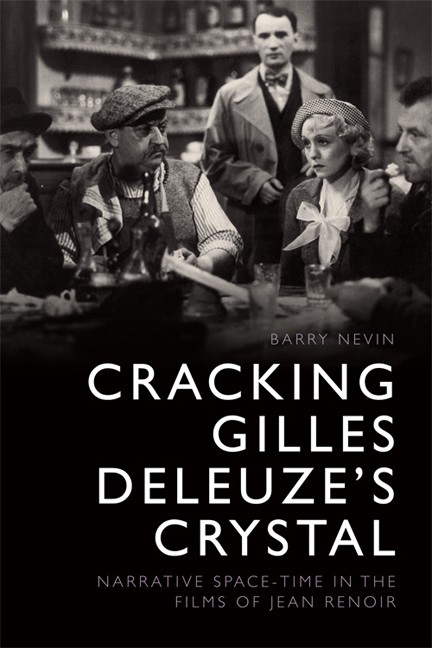Book contents
- Frontmatter
- Contents
- List of Figures
- Notes on Style
- Acknowledgements
- Preface
- Introduction
- 1 Theatrum Mundi: Framing Urban Dynamics in Renoir's Paris
- 2 From Desert to Dreamscape: Viewing Renoir's Rural Landscapes as Spatial Arenas
- 3 Portraying the Future(s) of the Front Populaire
- 4 Renoir's Crises Anti-Réalistes: Framing le Temps Gelé
- Conclusion
- Appendix: Corpus Breakdown
- Notes
- References
- Film Index
- General Subject Index
Conclusion
Published online by Cambridge University Press: 01 May 2021
- Frontmatter
- Contents
- List of Figures
- Notes on Style
- Acknowledgements
- Preface
- Introduction
- 1 Theatrum Mundi: Framing Urban Dynamics in Renoir's Paris
- 2 From Desert to Dreamscape: Viewing Renoir's Rural Landscapes as Spatial Arenas
- 3 Portraying the Future(s) of the Front Populaire
- 4 Renoir's Crises Anti-Réalistes: Framing le Temps Gelé
- Conclusion
- Appendix: Corpus Breakdown
- Notes
- References
- Film Index
- General Subject Index
Summary
This book began with two central aims: firstly, to develop a framework that would allow us to integrate temporality into our analysis of Renoir‘s mise en scène of space with due consideration of the construction of social space, developments in filmmaking technology, and shifts in Renoir‘s ideological outlook; secondly, to argue that Renoir frames the mutually affective relationship between physical and social space at each stage of his career, producing an image of open space-time in which the possibility for change remains constant. Building on three key shortcomings of Deleuze‘s reading of Renoir, individual chapters specifically sought to emphasise the import of Renoir's recurring narrative settings, his attitude towards the French Left, and his deployment of spectacular costume design and décor towards his portrayal of open space-time. This Conclusion briefly summarises the ways in which the preceding analysis permits us to arrive at a more comprehensive appreciation of what Leo Braudy refers to as Renoir's ‘open world’ and to constructively reconceptualise the process of crystallisation portrayed by Renoir's films.
In L’Évolution créatrice, Bergson observed that ‘our perception manages to solidify into discontinuous images the fluid continuity of the real’, inaccurately condensing periods of evolution into a stable perspective that ‘is only a snapshot view of a transition’. Renoir's cinema contests such perspectives, so one can see why Deleuze lauds Renoir's work, even if, as Colin Davis rightly notes, Deleuze's conceptualisation of Renoir's work ‘is questionable in detail and in general, as the director's entire output is made to fit into a single category which does little justice to it’. Clearly, what obscures the relevance of Deleuze's philosophical framework is less its infeasibility than its application within Deleuze's own Cinéma volumes. The spatio-temporal ontology of Renoir's work is constructed around a range of ideological, technological, and plastic components, many of which are rendered legible by Deleuze and Guattari's spatial thought and by other spatial theories, most notably Doreen Massey's treatise on space-time.
- Type
- Chapter
- Information
- Cracking Gilles Deleuze's CrystalNarrative Space-time in the Films of Jean Renoir, pp. 179 - 187Publisher: Edinburgh University PressPrint publication year: 2018



